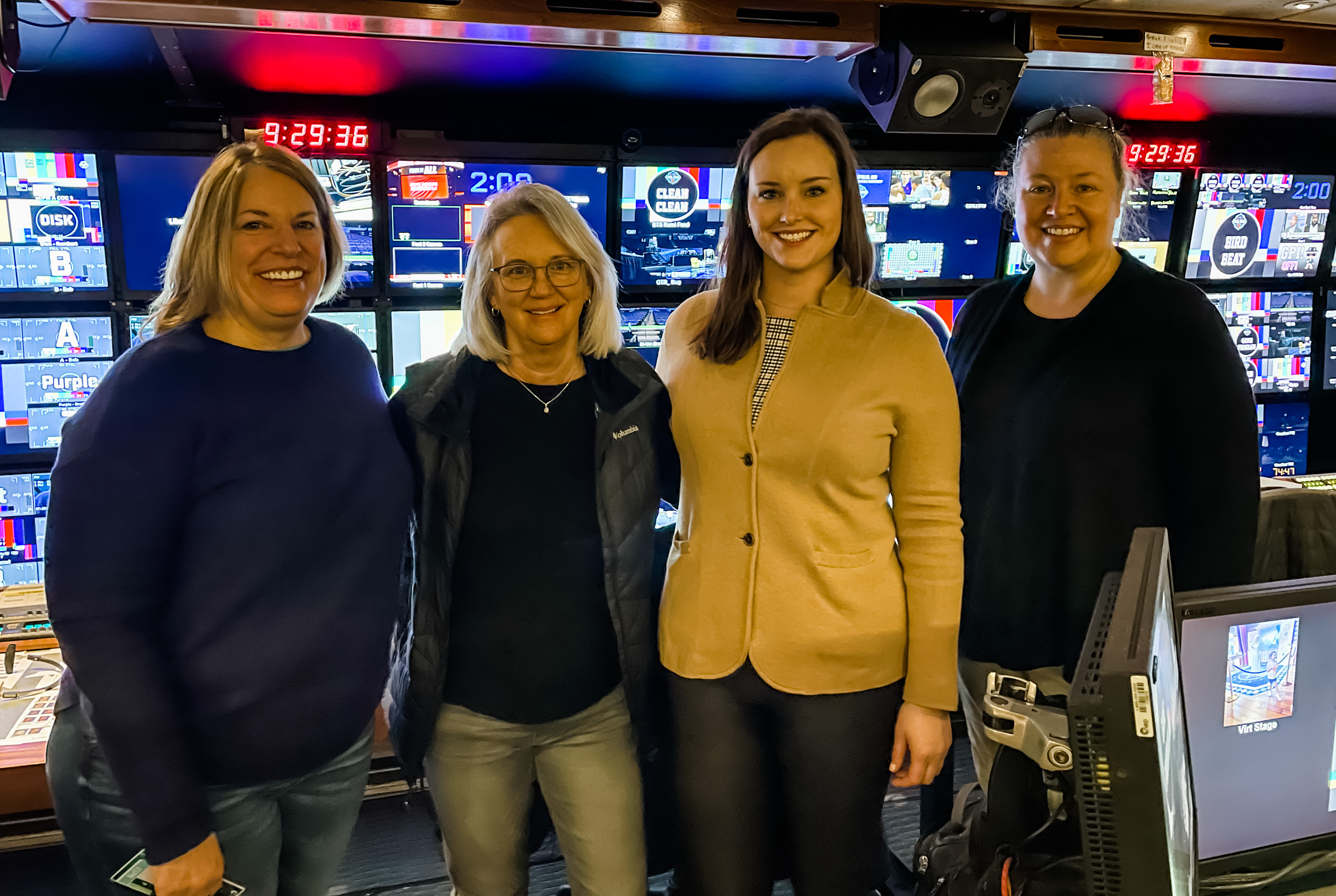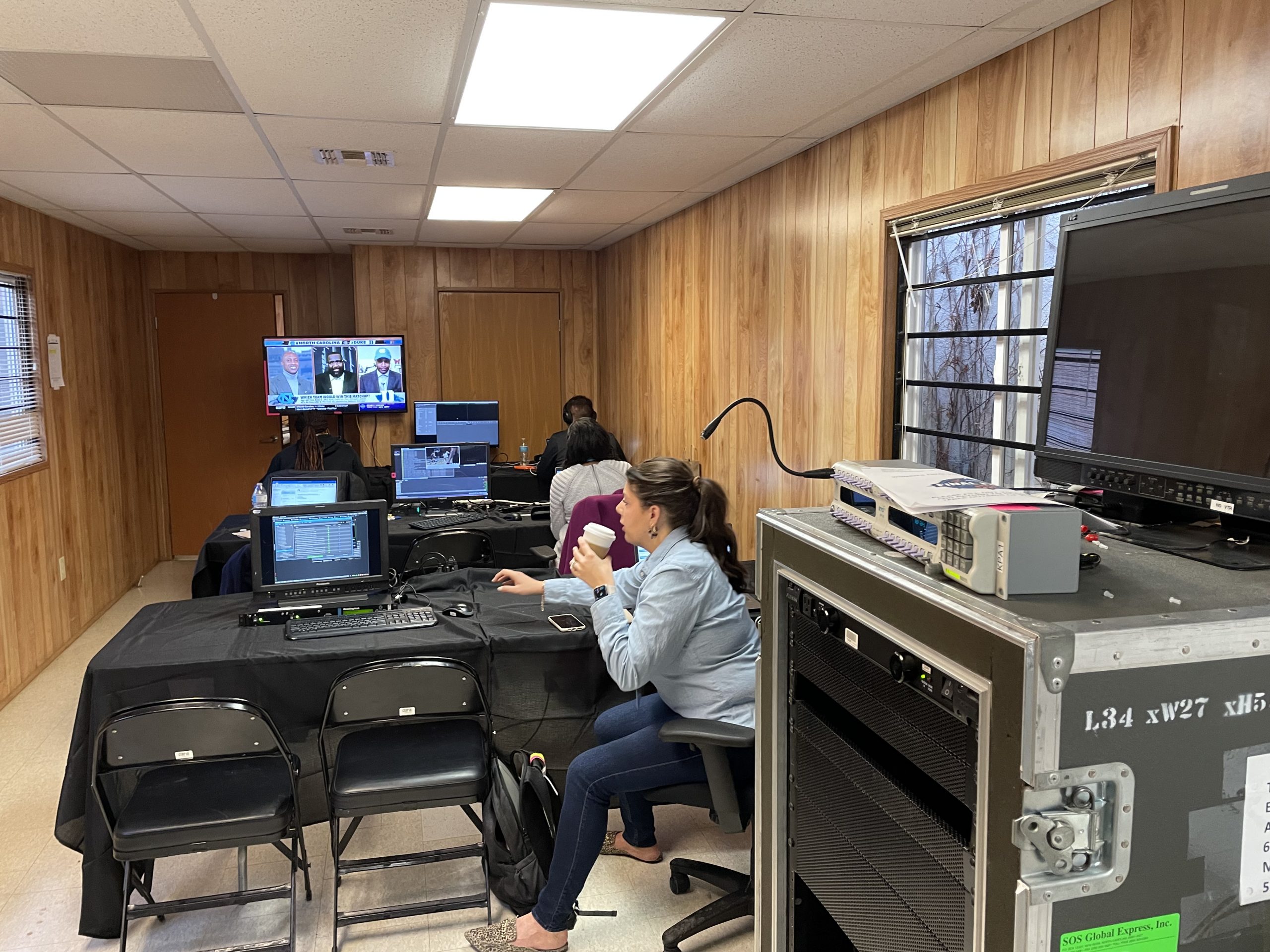Live From Women’s Final Four: Expansive Compound Includes Welcome Return of Onsite Edit Workflow
A crew of 250+ brings game, studio, MegaCast coverage to Minneapolis’s Target Center
Story Highlights
The Women’s Final Four has long been a labor of love for ESPN.
For the many ESPNers who work the NCAA Women’s Basketball Tournament each season, it’s an event that they have been a part of for a long time. It’s unsurprising, then, that faces light up at the chance to discuss just how much this show has grown in both prestige and production size.

More than 250 ESPN staffers are onsite in Minneapolis for the Women’s Final Four. Among the production and operations leaders are (from left) Coordinating Producers Beth Chappell and Pat Lowry; Associate Manager, Operations, Catherine Carroon; and Remote Operations Producer Traci Flohr.
A reflection of that growth? A crew of more than 250 people and a production compound housing multiple units of NEP EN1 (the same truck system used by ESPN to support the NFL’s Monday Night Football) are onsite in Minneapolis this weekend to deliver a Final Four that the broadcaster is calling its “biggest” women’s college-hoops championship ever.
“It was the smallest group [in the beginning] putting it together to make the event work,” recalls Beth Chappell, coordinating producer, ESPN, who started working on this event as a production assistant in 1997. “To see it grow from that to what it is now has been truly inspiring and amazing. People who have been on this project fall in love with it and continue to be on it for years and years. It’s equally incredible to see the newer people come onto this project and watch them find out how incredible this experience is.”
This year’s NCAA Women’s Final Four is a treasured one partly because of the welcome return to normalcy after the COVID pandemic wreaked havoc on the event. Following the cancellation of the 2020 tournament and a two-court, single-venue, fan-less tourney at San Antonio’s Alamodome in 2021, this year’s Final Four boasts the return of a grand, multipurpose production compound.
ESPN has rolled in multi-truck NEP EN1. The A unit will house the main game production, and B, D, and E will support various studio hits from inside the building and anchor some of the MegaCast options.
Additional units like a power generator and edit trailer hav had to be parked outside the arena’s dock because compound space is maxed out.
“It’s a tight space,” says Traci Flohr, remote operations producer, ESPN, “but the venue has worked with us every step of the way. The NCAA has done a great job of helping us understand every bit of space that’s available to us. Every year, the planning has grown and grown. We’re to the point now where we begin planning this event 18 months in advance. We’ve already done the first site visit in Dallas for 2023. It’s definitely a labor of love and something that the NCAA works in lock step with us on.”
Another key piece of the production returning to site this year is an edit trailer, where five Avid edit stations are set up. According to Operations Specialist Joe Rainey, ESPN is working off two AVID Symphony Nitrus systems hooked up to a 300-TB SAN. The edit trailer is crosslinked to the main trucks inside the compound and linked to Bristol through the broadcaster’s REMNAS file-transfer system.
For numerous events, including the NCAA Women’s Basketball Tournament, during the pandemic, ESPN did deploy workflows that kept much of the edit work at its Bristol, CT, campus. The ability to bring much of that work back to site, however, is a welcome return to normalcy for the crew.
“It’s a delicate dance to do a remote edit,” notes Harris Upham, edit technician, ESPN. “The time-tested formula is, the more of it you organically do onsite, the stronger the link and the connection to where you actually are. Otherwise, you could be shooting in a stadium anywhere.”
Additionally, the edit trailer houses an Avid Lite solution that assists in the uploading and managing of audition shots and preparing ENG footage for use in the live game broadcast and studio programming. EVS IPDirectors in the truck also allow manipulation and QC of content right from the main compound.
“It’s instant access, the ability to do these shoots and sit right down and edit,” adds ESPN Associate Manager, Operations, Catherine Carroon. “We’ve done it remotely in the past, and to be back onsite is so valuable to them. I know they are happy to be back.”
According to Operations Manager Jim Birch, ESPN will have 21 total transmission paths out of Target Center: 15 JPEG transmits and six JPEG returns with no ASI encoding. The Bird & Taurasi Show MegaCast options will utilize a 13-path REMI and single service fiber backhauls for Studio and Game. 2Gbps of bidirectional data will be utilized to support REMNAS, 20 VoIP lines, four IP encoders, Corp Wi-Fi, IPTV, Mobile Unit internet, and other ancillary data needs in the TV compound. Preproduction for both game and studio was executed on two on-site Avid Symphony edit systems.

